
Raising the Roof: Part II
An all-star benefit concert celebrating the 50th anniversary of Fiddler on the Roof, its Pulitzer Prize- and Tony-winning lyricist Sheldon Harnick and the 100th anniversary of The National Yiddish Theatre-Folksbiene will be presented June 9 at 7:30 PM at New York's The Town Hall. Co-conceived and co-directed by Fiddler vets Gary John La Rosa and Erik Liberman, Raising the Roof, which will feature renditions of classic Fiddler numbers by their originators and notable successors, will boast the talents of Topol, who created the role of Tevye on the London stage, reprised his role in the film and returned to Broadway with the role in 1990, as well as Joshua Bell, Jerry Zaks, Andrea Martin, Adrienne Barbeau, Liz Larsen, Austin Pendleton, Louis Zorich, Pia Zadora, Fyvush Finkel, Joanna Merlin, Rosalind Harris, Neva Small, Robert Aberdeen, Sammy Dallas Bayes, Maurice Edwards, Tanya Everett-Bagot, Louis Genevrino, Sandra Kazan, Joe Ponazecki, Carol Sawyer, Roberta Senn, Leslie Alexander, Joanne Borts, Mike Burstyn, Rachel Coloff, T. Doyle Everett, Michael J. Farina, Kerry Frances, Deborah Grausman, Jackie Hoffman, Rebecca Hoodwin, Lori Ada Jaroslow, Frank London, Michele Marsh, Faye Menken-Schneier, Carolyn Mignini, Larry Ross, Mark Sanders, Donalyn Petrucci Shreve, Harriet Slaughter, Cheryl Stern, Mimi Turque-Marre, Lori Wilner and a choir of 36 children.
In anticipation of the one-night-only event, several stars of Fiddler — on Broadway, on film, around the country and around the world — have offered recollections of their time in the musical, which is based on the stories of Sholem Aleichem and features a book by Joseph Stein, music by Jerry Bock and lyrics by the aforementioned Harnick.
Enjoy these "Anecdotes from Anatevka"; click here to read last week's memories.
(Also, NYT/Folksbiene has launched a social media campaign, asking readers to share their anecdotes about any production of Fiddler in which they may have appeared as well as a photo from the production. Go to twitter.com/folksbiene or facebook.com/folksbiene to share your own memories.)
| |
 |
|
| Mimi Turque-Marre |
Hodel/Tzeitel, Fiddler on the Roof (Replacement, Original Broadway Company) It was customary for a farewell party to be given to a departing actor at intermission, and our talented wardrobe mistress would present a doll costumed like the character he/she had been playing. I became pregnant while playing Hodel and was in denial about "showing" so very early. Week after week my costumes got suspiciously tighter, and I began to believe they were being washed in very hot water. At intermission at my last performance, I was given a beautiful Hodel doll, clothed in the green dress she wears at the wedding, and it had a distinctive bump. That's when I first realized how much I'd been "showing"! By the way, my "sister" Bette Midler arranged a beautiful shower for that baby who had been clearly announcing his presence on stage.
| |
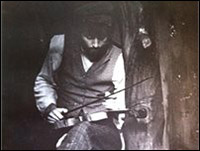 |
|
| Sammy Dallas Bayes |
Original Yitzuk, Fiddler on the Roof (Original Broadway Cast, 1964)
Ensemble, Fiddler on the Roof (1971 film with Topol)
Fiddler, Fiddler on the Roof (1976 Broadway Revival)
There is a movie called “Sliding Doors.” It follows one person who steps into a subway car and follows the direction her life takes from there on... Juxtaposed, that same person starts to step into the subway car, but for some obscure reason decides to catch the next train. That small decision completely changes her life’s direction from what it might have been stepping into the first subway car.
Hence my story: It was down to the final dance call for male dancers being considered for the original company of Fiddler. The line was down to a few more than needed. Jerome Robbins and assistant Tommy Abbott were in heavy discussion as to whom of the final two would be best for what was needed. I was one of the two being discussed. Robbins was leaning towards the other dancer. Tommy was leaning towards me. From what I was told their discussion became exasperating. Both myself and the other dancer had qualities that were right for what was going to be needed (we were two completely different dancers in shape, size and technical training), but there was only one spot left. Frustrated with the circumstances, Jerry threw his hands in the air saying, “Alright! Take them both.”
Rehearsing at the Lyceum Theatre prior to going out of town I got permission from stage manager Jim Bronson to use the stage during lunch hour. I had hit it off with another cast member with the same background training as myself and wanted to work on choreography. (I wanted to do a concert of works once we returned to New York.) Oh yes, that cast member was Sue Babel, a wonderful woman with an incredible spirit! Upon return to the city, Jerry came to see a rehearsal of my concert. Afterwards we had a coffee while he critiqued my work. He told me he was familiar with how I worked. I asked, “How’s that?” He said he heard me talking to Jim Bronson about using the stage. He would go out the stage door come in the front of house, sit in the balcony and observe my work. This led to Jerry asking me to notate all the musical numbers for Frank Loesser’s Frank Productions (now MTI). I became entrusted by Jerry to stage first class productions wherever and whenever Tommy Abbott was not available. And after a year of working on the choreography book for Frank Productions, Frank Loesser offered me my first Broadway show as a choreographer, Canterbury Tales.
“Alright! Take them both.” Those words from Jerry Robbins were my “Sliding Doors.” I have had a wonderful career born out of those words. Celebrating this 50th anniversary of the show and creative team who gave it its birth is an absolute mind-boggling event. I am honored to be a part of it. Oh, by the way, that other dancer? Duane Bodin.
Thom Koutsoukos (written by Deborah Packer Koutsoukos, his wife)
Original Yakov, Fiddler on the Roof (Original Broadway Cast, 1964)
I put together some thoughts re: your suggestion for Thom to write something for this gala. It is difficult to speak for my brilliant husband because he was such a wonderful and articulate story teller. I could never hope to do him justice but as I have been hearing Fiddler stories since we first met more than 35 years ago, I can at least try to capture his words and his voice. I know that Fiddler was a life-changing and life-affirming experience for him, one that he spoke about over the years with great affection and humor. Everyone who worked with him or met him and found out that he had been in the original cast always wanted to know about it. Even Hershel Bernardi, when years later in the 80's, brought a touring Fiddler to Los Angeles (he was the second Tevye after Zero, as you know, and we were invited to a performance). He asked Thom, "Was it as good as you remember it?" For Thom, it was the joy of working with both Zero Mostel and Jerry Robbins that gave him the greatest sense of belonging to something special. He spoke eloquently about Zero's kindness to him during a particularly difficult time. Or, how during his numerous stints as Perchik, Thom would hear Zero affectionately taunt him on stage during numbers in an attempt to break him up. (Oops, you didn't hear me say that!) Or, the time Thom was walking down Broadway to the theatre only to suddenly hear screeching breaks and a booming voice yelling,"GET IN THE CAR! GET IN THE CAR!" Zero, of course. Or, the fascination of those Hasidic weddings that Jerry Robbins made them attend so that they could experience it firsthand.
Fiddler opened up an exciting new world for Thom, a far cry from his Greek Orthodox upbringing in the Chicago of his youth. And although Fiddler was Thom's second Broadway show (the first Oh Dad, Poor Dad… that Jerry Robbins directed), it was this show that gave him friendships that would last a lifetime and perspectives that for a curious, bright and open-minded young man, set his life's course in so many ways.
Thom went on to play many parts over the years, but he always referred back to his four years in Fiddler as the most meaningful of his life. That experience gave a more mature Thom the ability to portray Al Jolson years later in the first production of Michael Druxman's one-man show, Jolson, in Los Angeles (under the name of Thom Keane), and while he may not have looked or sounded so completely like Jolson, the audiences, many of whom knew Jolson personally (including Betty Garrett, whose husband Larry Parks had a difficult time working with Jolson during the filming of "The Jolson Story"), were overwhelmed by Thom's acting ability. How he seemed to capture the essence of a man who privately spoke with a lot of Yiddishisms. Thom probably knew more Yiddish than I did, and I was born into it! It was simply that beginning in 1964 that would continue to challenge and influence him in years to come. Interestingly, when Thom's mother died a number of years ago, it was a Yom Kippur service that he attended with me that gave him the most comfort. Thom would want to say hello to all who remember with him that endearing time, a special hello to the wonderful Hal Prince and a very special thank you and Happy Birthday to the amazing Sheldon Harnick.
| |
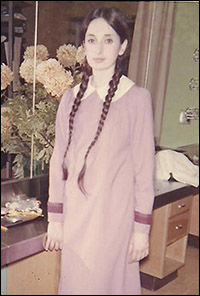 |
|
| Roberta Senn |
Original Anya, Fiddler on the Roof (Original Broadway Cast, 1964)
. My audition story as reported in Alisa's book. My very first audition upon arriving in NYC was for Fiddler. I showed up for the audition (which was advertised as Russian Folk Dancing) dressed in my yellow skirt and red boots and my hair in braids. Everyone else had low cut leotards and fishnet stockings. Jerome Robbins watched me dance and told me that I was in the show. I am Russian Jewish, my grandmother lived in a shtetl, and Jerry built the whole show around my look. 2. The most fun was Maria Karnilova and I doing the barre onstage every night before the show. Also, Jerome Robbins loved me and treated me as a pet or as a muse for the show. Zero Mostel also treated me very sweetly. Zero and Jerry hated each other, and I loved them both so I was caught in the middle.
| |
 |
|
| Carolyn Mignini |
Sima, Fiddler on the Roof (Replacement, Original Broadway Company)
Unforgettable! It was raining the day I auditioned for Fiddler. It was my first and I was so thrilled to be backstage at an actual Broadway theatre that I couldn’t stop grinning. I had a pixie haircut and wore a short white jumper with a puffy pink blouse and white vinyl boots! How in the world I got the job, I’ll never know. Adrienne Barbeau and I became friends during the show. She and I and Bette Midler would meet onstage at the five-minute call and warm up, singing 50’s pop standards. We’d harmonize and rock out. It was great fun. Who knew we were part of something so timeless? We were just living the dream.
| |
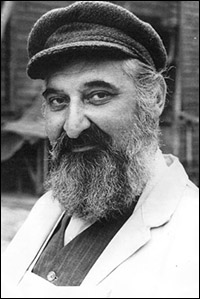 |
|
| Fyvush Finkel |
Mordcha, Fiddler on the Roof (Replacement, Original Broadway Company)
Mordcha, Fiddler on the Roof (National Tour, 1966)
Mordcha, Fiddler on the Roof (Broadway Revival, 1981)
When I signed to do the national company of Fiddler on the Roof, to me that was beginners luck. I was 43 at the time, and that was my first show that I was going to do in English. And naturally, I was chosen by Jerome Robbins and Harold Prince. So, we rehearsed it for three weeks but before we go out, on the fourth week, we must do a run-through, which every year theatrical casts would do that go on the road….so they can see how the audience reacts and how much business they can do. ...
So usually the run-through, you would have 100 people, 200, maybe 50 but the gypsy – they called it a gypsy run-through -- but it was actually a complete run-through with the actors. Everybody was watching: the scenic people, the director, the producers, the backers. So, with Fiddler on the Roof, people found out that I was going to be in it. My grocery man said to me, “Fyvush please, maybe, you know, we can’t afford tickets,” which in those days was $10 a ticket! Well, you know, to see Fiddler on the Roof, to them, that was something captivating, something that they must see because they lived through that…the people that lived in my neighborhood, in Brooklyn, at Crown Heights…
So, I said, “I’ll tell you what…if you can take a show with just tables and chairs and a piano player – naturally the cast will be there – then you can come down.” “How many people can I bring?” they usually asked. So, we were told by the management, “Bring as many as you want!” So I said, "Bring your family. It’s okay! Just walk in that day and that ends it.”
Well, now it’s time! We are getting prepared for the gypsy run-through! I figured, well maybe, 200 people will be there…a hundred. I wasn't alone…don’t forget it was a very big cast. We take a look: 1,800 people came to that gypsy run-through to see Fiddler on the Roof with Luther Adler as the star, and the place was mobbed! And the ovations! And we couldn’t believe…and we got such a thrill with that performance. With the stage manager yelling out, “Blackout! Act One! Act Two!” The excitement that we had in the audience…that was the highlight of the four years that we went on tour with Fiddler on the Roof! ... That run-through we did for the actors and the public and for everyone involved in the show. And, we got ovations! Had we gotten those ovations in the theatre, my God, the show would have run another 20 years! We couldn’t believe it, I couldn’t believe it either. And, to me, that was the highlight, the highlight of not only being on the road…it was the highlight of my career – was that run-through!
And, after we finished, Harold Prince, the producer, came over to us, he says, “What am I spending money for scenery for? We could have done this show with tables and chairs and only a piano!” He said, “Take a look what was happening here this afternoon.” Even he was raving about that run-through. Raving! And I didn’t blame him a bit, by God. And actually, on the road, those were the ovations that Fiddler got in 1966 on to 1970.
| |
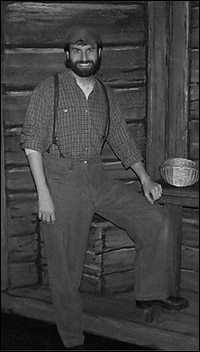 |
|
| Mark Sanders |
Perchik, Fiddler on the Roof (2000 National Tour with Theodore Bikel)
There is truly nothing like the Fiddler family. During the 2000 national tour, I fondly remember the nights the cast and crew would gather to hear Theodore Bikel play his guitar and sing. You could hear a pin drop as he sang his signature song, “Edelweiss,” as no one else can. The incomparable David Masters would constantly entertain us with his vaudevillian energy…truly “one of the greats.” We were a family on, and off, the stage.
One show in particular that stands out was during our week at the Kravis Center in West Palm Beach. It was during a local musicians’ strike, and the actors were expected to “go on with the show” with only two pianos. So, as the curtain rose, the audience was met with the silhouette of the Fiddler, only to hear a single piano doing its best to mimic that sound synonymous with the opening of the show. Theo wore a black armband in solidarity. The story was still told and the songs still sung, but it just wasn’t the same. Not until Sheilah Walker was able to step back onto the podium and conduct the glorious orchestrations that our Fiddler family was once again complete. No other show compares to Fiddler on the Roof, and I am blessed to be part of it all.
| |
 |
|
| Donalyn Petrucci Shreve |
Hodel, Fiddler on the Roof (Broadway Revival, 1981)
I was cast as Hodel after the entire company had already been in rehearsals for two weeks. That said, as well as being Italian Catholic, I had a lot of catching up to do. I began rehearsal where all the daughters are in the house and Papa comes home, so all the daughters go running out of the house to greet him. Sounds simple enough. So we begin and off I go running out of the house and Jerome Robbins yells, "Stop, Stop!" and he points his finger at me. "Dona, every time you enter or exit the house you must touch your hand to the Mezuzah. It's a constant reminder of God in our lives." My response, "Ooooohhhhhhh, OK, I get it." So, off we go again. All the sisters are in the house..... Papa comes home ...... we all go running outside to greet him and Jerome Robbins yells, "STOP! STOP! DONA! " Totally surprised that he's pointing at me again, I said, "What did I do? I hit the Mezuzah like you said." He responded, "Yes, but then you made the sign of the cross after it!!!!!" And, so started my first day in Anatevka.
| |
 |
|
| Joy Hermalyn |
Rivka/Fruma Sarah, Fiddler on the Roof (Broadway Revival, 2004)
1. Fruma Sarah: From opening night to closing night, was the most exciting time in my professional life - it is truly one of the greatest entrances and exits in all of musical theatre, and I felt lucky to play her on Broadway. One day, Fruma with the 30-foot dress and train, flew up 30 feet into the air and couldn't find the ladder to hold onto and went spinning like a top for the entire sequence!
2. Jerry at the piano with Sheldon singing "Topsy-Turvy" for us very early in rehearsal - which was dug out of a trunk and tweaked, I believe, to use as a replacement for "The Rumor." It was as if time had stopped - listening to these two men, as if they just wrote the whole show, giddily singing back and forth to each other this song of complaint and resignation - we knew we were small cogs in this incredible universal wheel. It was such a thrill to sing in that piece every night as no one could sing along!
. Our many cast members over the two years were truly a family - the pogrom and then the heartbreak of leaving after Anatevka played an enormous part in bringing the actors who were the "Jews" and the "Russians" even closer together in life.
4. As a Jewish mama myself, I always felt connected to the plight of Anatevka - I recently spoke and presented the "Breaking of the Glass" ritual at the wedding of Craig Ramsay - an original Russian in our show, for whom the wedding scene resonated and his now husband, Brandon Liberati. It was easy to find the parallels in the struggle of the Jewish people and the struggle for Marriage Equality. At its core, Fiddler is about human rights and freedom - in its 50 years it is still telling the tale and hoping for change. But in the meantime we suffer!
| |
 |
|
| Gary John La Rosa |
Ensemble, Fiddler on the Roof (Broadway Revival, 1990)
Ensemble, Fiddler on the Roof (National Tour with Theodore Bikel, 1996)
Ensemble, Fiddler on the Roof (European Tour, "Anatevka")
It was my first Broadway experience as a child, and I made my Broadway debut performing in the show (sharing a dressing room with my "Tevye," Jerry Jarrett) 25 years later. Over the years, I have been involved in dozens of productions and have been humbled to have all the creators see my work on it. I am amazed by its unique emotional power on an audience and delight in how it continually threads through my life and career.
| |
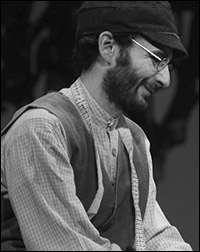 |
|
| Erik Liberman |
Motel, Fiddler on the Roof (National Tour with with Topol; Theodore Bikel; Harvey Fierstein)
When my grandparents told me stories of surviving pogroms, I had no understanding of them; they were just folklore. Fiddler awakened my connection to that ancestry while allowing me to honor my grandparents' memory. I must be the only person on Earth never to have seen a production of Fiddler before doing it [on the 2009-2010 North American tour] — so working with Topol, Harvey Fierstein and Theodore Bikel was a true "master class" in unlocking this brilliant material.
[The Town Hall is located at 123 West 43rd Street between Broadway and 6th Avenue. Tickets start at $75. Contact (212) 213-2120, ext. 203 or visit nationalyiddishtheatre.org.]
*
Well, that's all for now. Happy diva-watching! E-mail questions or comments to [email protected].
Diva Talk runs every other week on Playbill.com. Senior editor Andrew Gans also pens the weekly columns Their Favorite Things and Stage Views.









